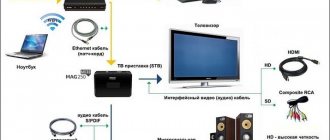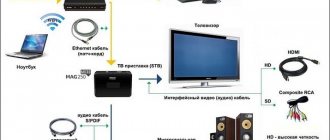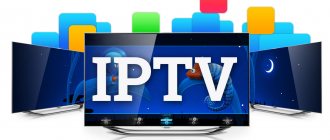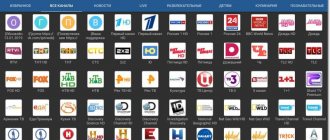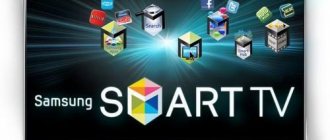Main OTT services in Russia
- Published by: KalovskiyBronislav 2020-10-29
OTT is a new generation of Internet television based on IPTV technology.
In 2021, the Russian video streaming service market grew by 50% compared to the previous year. According to analysts, it will grow by 12% annually until 2023. Modern users are willing to pay for mobility; it is important for them to receive the necessary content in a place and time convenient for them. OTT television solves this issue - the service provides high-quality video content anywhere and on any device, the main thing is to have access to the Internet. The OTT service market is constantly expanding, but several leaders have emerged in it.
OTT TV. Materiel
There is no clear definition of the term OTT (over-the-top TV) in the media community. Some believe that OTT is Internet television, others that it is the ability to watch TV channels on smart TVs and mobile devices, for others it is a technology for transmitting data via unicast messages. Opinions agree on one thing: OTT is not IPTV, but this definition, to put it mildly, is not accurate. Let's try to figure it out.
The reason for the confusion and difference of opinions is, among other things, the insufficiently correct definition of OTT in open sources. To quote Wikipedia:
OTT technology (abbreviation for Over the Top) is a method of providing video services over the Internet. The term OTT means the delivery of a video signal from a content provider to the user’s device (set-top box, computer, mobile phone) over data networks, often without direct contact with the telecom operator, in contrast to traditional IPTV services, which are usually provided only through a network managed by the operator itself. network with guaranteed QoS (QoE).
What's wrong? To answer, let's look at the IP protocol stack:
An experienced specialist can see at first glance that all data transmission protocols go on top of the main IP protocol, therefore, any technology used for video transmission (be it multicast or unicast) is IPTV. There is no distinction between data transfer over the global Internet or through an internal managed network. Only the video transmission protocols themselves differ, but they are all built on top of the IP protocol, and this is IPTV by definition.
What kind of technology is OTT then, and how does it differ from IPTV? We believe that they cannot be directly compared at all; they are different phenomena. In reality, OTT is not a data technology. This is not a technical term, but a marketing term, indicating that the service is provided on top of existing infrastructure, often owned by third parties. Thus, the Aliexpress online ordering platform can be considered an OTT project, since third-party courier services are used to deliver goods, unlike pizzerias that have their own delivery staff. We gave this exotic example to confirm that the OTT model is not limited to the Internet. And in real life, OTT TV solutions use IPTV technology.
Before discussing several OTT solution schemes, let’s remember one more term: Middleware IPTV. The so-called Middleware belongs to the class of intermediate software. Looking at the illustration below, it becomes clear why.
Middleware acts as a coordinator for the interaction of various systems and is located between them.
Here are several examples of IPTV solutions that are absolutely technologically equivalent, but in the first case we are talking about OTT in the market sense of the word, and in the other - not.
The first option: the interactive television operator provides the subscriber with the service on its network. The second option: the same subscriber watches TV channels available to him via subscription outside the home (at work or while visiting), where the provider is another telecom operator. The subscriber uses his smartphone or carries a set-top box with him, or simply uses his login on someone else’s smart TV. In this case, the technical part remains the same for the subscriber; while visiting, he receives the service as at home, using his operator’s application, but is on a different network. This is pure OTT.
Note that option 1 is a classic for the provision of cable television services, implying certain requirements for the operator, which are regulated by the rules for the provision of cable television services. For example, the equipment of the conditional access and content protection system must have a certificate in the field of communications, free broadcasting of channels of the first and second multiplex with regional inserts (this is monitored by Roskomnadzor). OTT, however, is not regulated by such rules: as soon as a subscriber leaves the territory of the home network, he, by law, ceases to be a user of cable TV, and the requirements of the Ministry of Telecom and Mass Communications “disappear” - OTT is outside the legal framework, it is not defined. With a change in the connection point, the procedure for providing the telecom operator’s services changes. The line between an OTT service and a cable television service lies along the border of the telecom operator's network.
An OTT service can also be differentiated from a cable television service by the presence or absence of a direct contractual relationship. Pay attention to the peculiarities of how content aggregators work. An aggregator in official terminology is the same telecom operator as its client providers. The aggregator has a license for cable broadcasting and licensing agreements with TV channels. He doesn’t have one thing: his own subscriber network, so he rents it from the telecom operators with whom he works (hello to Anton Bogatov!). The presence of a lease agreement indicates that the aggregator operates within the legal framework of television broadcasting and provides cable services. Once the network lease agreement is terminated while continuing to provide access to television content, the process turns into an OTT service.
The presence of a network lease agreement in the first case and its absence in the second is the difference that separates the classic cable television service from the OTT service.
We have shown with examples that IPTV is a dual-use technology that allows you to build solutions within your own network as communication services and outside the network as an OTT service. The technical platforms on which specific solutions are built, depending on the conditions described above, ensure the operation of OTT, or IPTV models, or simultaneously. This is most clearly seen in the work of global cloud platforms that provide operators with middleware and CAS systems for rent (PaaS technology). The final choice of business model is up to the operator.
Thus, OTT (OTT TV) is a term denoting a business model in which a video service is provided to the client directly from a so-called OTT provider (content provider or distributor) over a third party infrastructure, using technology (for example, IPTV) ensuring the absence of any approvals/agreements on the use of this infrastructure.
PS Definition of OTT from the reference book of the Ministry of Telecom and Mass Communications - “OTT (from English Over the Top) is a method (format) by which information, a set of data (digital content, files), is divided into IP packets and delivered from one computer to another via an uncontrolled Internet (via networks of third-party telecom operators) from source to recipient. The fundamental difference between OTT and IPTV is that the network’s Internet provider does not control the OTT service, and the OTT service does not control the network (and does not guarantee signal quality).”
Write in the comments your guesses as to where the definition was copied from and what the fee for the directory author is. 
Ivi
In 2021, the online cinema Ivi.ru had the largest audience - 36% of the total number of viewers. Some films and TV series are available for free (this is possible by showing commercials before, during and after viewing). Films in their original language and premieres, as well as box office leaders, are available with a paid subscription. Video viewing is available through a browser or application on your phone or TV (you can use up to 5 devices). The cost of a monthly subscription as of July 2021 is 399 rubles[1]. When purchasing a subscription for a longer period, the price per month will be lower.
Smartphones
According to the relevant divisions of the Google B4 global network, at the end of 2021, 29% of smartphone users in Russia distribute and watch video information through Instagram, VKontakte, Facebook Messenger and others, which means that the smartphone is currently manifesting itself as a mass basic “second screen” " Moreover, the manufacturers of these devices have outlined about 15 directions for the development of smartphone production technologies in 2021, which makes their use in OTT technologies basic.
It is worth mentioning the fashionable design of smartphones called frameless. The screen of a smartphone with this design occupies more than 90% of the smartphone's area. And this is attractive when watching TV and video content. One of the first is the MiMix model from Xiaomi with a Snapdragon 821 processor. Huawei and Samsung are also working on smartphones with a huge screen. Due to the use of powerful and inexpensive hardware platforms, as well as reducing the cost of screens, Full HD and HD standards will become common for budget models of frameless smartphones in 2021.
Also attractive for the user is the increasingly frequent use of Amoled screens in smartphones in 2021, which are superior in saturation and contrast to conventional IPS matrices. The developments of Samsung and Apple are advanced in this area.
Very important in the development of smartphones in 2021 is the use of graphene batteries, which have characteristics superior to those of lithium-ion, primarily in charging speed. A graphene battery charges in a third of the time it takes to charge a lithium-ion battery of the same capacity. And in fast charging mode for a standard capacity, the graphene battery is charged in a few minutes. The specific capacity of graphene batteries is 1000 Wh/kg at a voltage of 2.3 V. For conventional lithium-ion batteries, this figure is five times less and amounts to 200 Wh/kg. In addition, they are very light, which helps reduce the weight of the smartphone. Qualcomm's new Quik Charge 4.0 technology can charge a conventional lithium-ion battery to 100% charge in 30 minutes.
Thus, these and other promising developments further strengthen the position of the smartphone as a “second screen” in OTT technologies.
Okko
Okko has second place in terms of the number of users. After its purchase by Rambler, the service’s position increased by 96% over the year. Like most analogues, with an Okko account you can watch thousands of films, TV series, cartoons, programs, concerts and performances on any 5 gadgets.
The cost of subscription is from 199 to 799 rubles per month when purchasing package offers for 10, 30 and 40 thousand available titles of films and TV series. There are also thematic packages (for example, “Paramount+”, “Amediateka” and others) at prices ranging from 199 to 599 rubles.
Megogo
This is one of the most technologically advanced services that broadcasts cable and terrestrial channels. From an extensive library of video content, the service creates its own channel packages for the user. On Megogo you can watch TV programs, films, series:
- some of them are available for free, but you will be shown advertising (several commercials before starting, as well as banners while watching);
- others are available when subscribing to a monthly package (there are several options - from 197 rubles for the minimum package to 597 rubles for the premium package);
- premieres that are shown in cinemas (they can be rented or bought forever).
After linking your card to the service, you will be able to buy or rent movies in one click. You can connect 5 different devices to your account.
Megogo actively operates a bonus system for customers. You can receive bonuses for movie ratings, comments, recommendations on social networks and active use of the service.
Peculiarities
Currently, the OTT service is not considered a method of delivering video content, which is terrestrial, cable, satellite and IP broadcasting. All these methods of delivering event information, accompanied by synchronized audio, are continuous, programmed for each period of time and are designed for a large audience of simultaneous viewing.
OTT content delivery is personalized. If earlier, with traditional broadcasting, the viewer was offered a program guide and the viewer chose from it what he wanted to watch, and if he did not find what he liked, he switched to watching the program on another channel, but now the viewer is invited to program his own viewing. After all, television channels differ in program topics and are designed for different audiences.
Naturally, OTT services are more popular primarily among viewers under 30 years of age. These technologies are “native” achievements of the Internet. And there are social networks, which are mostly used by young people, since they allow them to communicate in real time with guaranteed feedback. In addition, in such a situation, loyalty to OTT technologies flows from one age segment of generations to another.
OTT services have learned to work with social networks and extract personalized content based on the preferences and reviews of Internet users on social networks. And the emergence of cloud services such as Paas (Plat-form-as a Servise) Saas (Softweare-as-Servise) and others have generally simplified the organization of such an OTT service as VoD (video on demand). In this case, the operator does not need to spend much on creating and organizing their offers.
Launching a VoD service comes down to connecting a prepared video library to a cloud server and providing a viewing service, generating personalized streams for any number of independent viewers online. All components of the VoD service organization scheme are already contained in the cloud platform. The question only comes down to paying for cloud capacities. Cloud platforms also have very efficient ways to deliver personalized advertising.
It should be noted that OTT technologies are not only VoD services and online cinemas. This concept includes many other types of Internet services. Thus, at the international conference “Development of OTT services in Russia - OTT Russia 2016”, held in Moscow at the Holiday Inn Suschevsky hotel on October 19, 2021, it was noted that the concept of OTT includes services such as Internet telemetry, Internet of Things (IoT), video communication and five or six other types of Internet services.
Amediateka
The OTT service is the brainchild of one of the largest Russian film companies, Amedia. It produces films and TV series, which, along with many others, are presented in the online cinema. This project received the Home of HBO status in Russia, which gives it the exclusive right to show the products of the American company. In addition, Amediateka cooperates with such famous world studios as Showtime, FOX, ABC studios, BBC, CBS.
The cost of the main subscription is 599 rubles, there is a trial period lasting one week.
Cloud based IPTV
Previously, traditional telecom market players expressed fears that OTT would “eat everyone.” But time has passed, and we see that operators not only do not see a threat to their business from this technology, but are also launching IPTV services on the OTT platform. This is exactly the business model that TTK followed, implementing its project in collaboration with Lifestream LLC (Smotreshka brand). As the participants of this project explained to a Tele-Sputnik correspondent, launching a service on your own takes time and requires serious financial investments, which is not acceptable for everyone in our difficult economic times. Using a ready-made cloud television service platform allows you to solve all problems in one fell swoop.
At the same time, TransTeleCom purchases content independently. The operator has concluded agreements with a number of suppliers, plus negotiations are underway with online cinemas. Subscribers have access to interactive TV, including HD channels with the ability to rewind, pause, and view completed programs. It is planned to release an application for Smart TV, smartphones and tablets on Android/iOS, as well as launch video on demand. TransTeleCom's approach is interesting in that the company is ready to provide digital TV services in the networks of other operators. Let's add that profits are divided between partners according to the revenue sharing scheme.
Netflix
Netflix is an American platform for watching films and TV series. You won't be able to watch TV channels, but you'll have enough movies and TV series to last you a lifetime. The company also produces video content. Most of the materials are presented in English, but there are also films with Russian dubbing. Netflix has a very user-friendly media player that works on all devices. After registration, you can take advantage of a free trial period lasting 1 month. The number of available devices depends on the tariff plan. In the “Russian version” of the service, three tariffs are available, tied to the euro (in the range of 8-12 euros per month, which at the current rate is 655-983 rubles)
Other OTT services
Most of the Russian audience has already given preference to the large OTT services listed above. But this industry has only recently begun its development, and other market players, such as Start, Premier, TVZavr, Kinopoisk, Yandex Ether, are rapidly developing and are hot on the heels of the leaders. Several new services are being prepared for launch in 2021. Thus, despite the abundance of pirated content, users are gradually switching to legal services.
[1]Prices are current at the time of publication!
mgtsinfo
